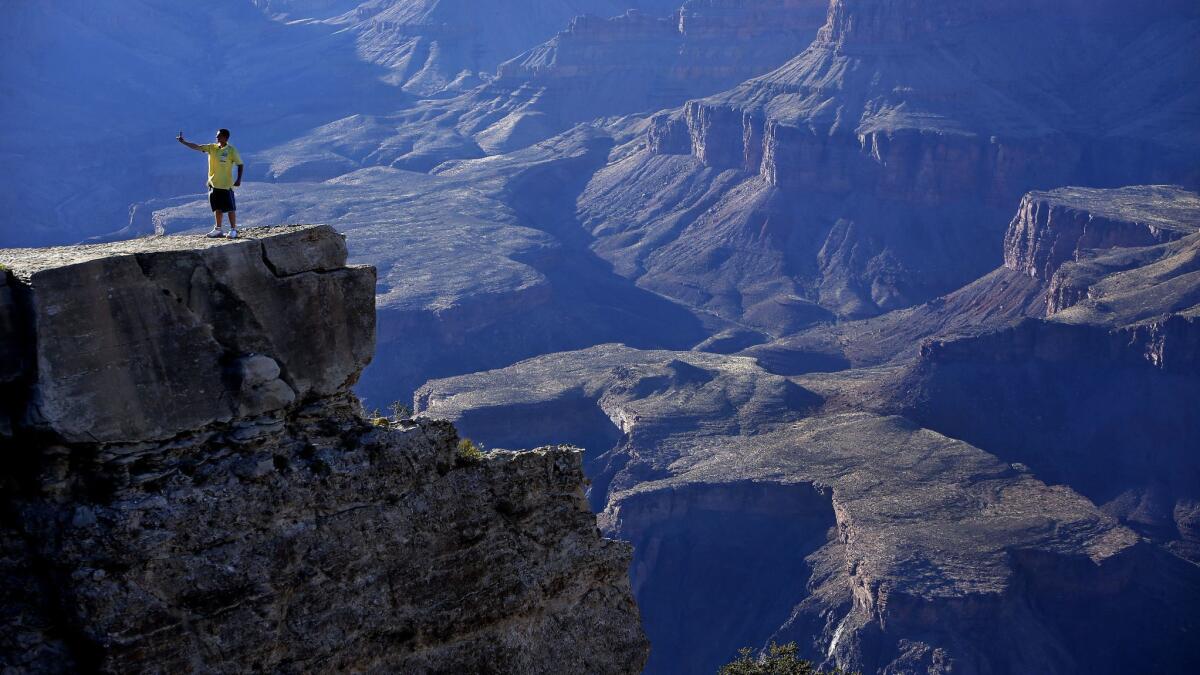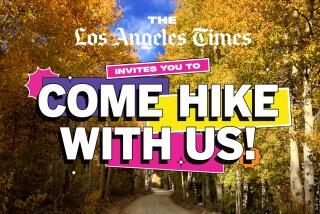Op-Ed: Why do otherwise smart people do such dumb things in the great outdoors?

Two hikers died last week after falling from Yosemite’s Taft Point, located high above Yosemite Valley. What exactly happened is still unclear, but they almost certainly stepped off the trail, past the guardrail and passed warning signs before tumbling hundreds of feet over the cliffs.
As a hiking expert, my favorite part of the job is encouraging people to trek up to places like Taft Point. But now my enthusiasm for the great outdoors is tempered by worry. There’s been an exponential increase in the number of lost hikers, injured hikers and, worst of all, hikers who die on the trail. In recent weeks, we’ve learned of a California woman who slipped and fell to her death while taking selfies on a trail high above Lake Superior in Michigan, and thrill-seekers suffering severe injuries while leaps off cliffs into shallow pools — just to put the video on their Instagram feed.
Why do otherwise smart people do such dumb things in the great outdoors?
Bad hiking advice pollutes comments on hiking blogs, Facebook posts and Yelp reviews, so it’s tempting to blame social media. The fault, however, lies not in Instagram stars, but in ourselves. It’s a disconnect from nature, a lack of even basic survival skills, and poor judgment that cause most troubles on the trail.
I’m haunted by the lives turned upside-down, or ended, by hiking accidents that can be prevented.
I recall a particularly horrible incident in the summer of 2011 when three college students stepped past the guardrail at the top of Yosemite’s 317-foot high Vernal Fall and into the Merced River. Other visitors pleaded with them to get out of the water, but one hiker slipped and started a chain reaction that ended with all three falling to their deaths.
The next day ABC World News called me, as a hiking expert, to comment. “My heart goes out to the families of the victims, as well as to the horrified onlookers who witnessed the tragedy,” I said, “while my head cannot comprehend the decision of the three hikers to step past the guardrail at the top of the falls and into the raging waters.” Since then I’ve had to deliver similar responses when asked about hikers killed and injured at 35-foot Eaton Falls above Pasadena and slender Tangerine Falls in the foothills above Santa Barbara, as well as hikers who died of heat stroke on tame trails in the Santa Monica Mountains and Hollywood Hills.
Lately, though, I’ve gotten more blunt. At a recent talk at the Adventure 16 store in West Los Angeles, my hiker safety talk de-evolved into a rant about tourons (tourists-morons) on the trail. I’ve abandoned all subtlety in my guidebooks: “Don’t climb Eaton Falls; people have recently been injured and killed doing this.” And “Last place you want to be in an electric storm is atop Half Dome, forced to make a hurried descent over slippery rock while holding on to wet metal cables.”
Enter the Fray: First takes on the news of the minute from L.A. Times Opinion »
I’m haunted by the lives turned upside-down, or ended, by hiking accidents that can be prevented. National Park Service studies of accidents that required the agency to launch a search and rescue operation determined that the vast majority of these accidents wouldn’t have happened to people with rudimentary outdoors knowledge, better preparations and the proper gear.
It’s crucial that those of us with hiking wisdom to share greatly increase our efforts to teach others trail sense and tips about getting along in the natural world that were once routinely passed down from one generation to another. Good hikers know how to manage in cold weather and hot, choose hikes matching their abilities, and can identify poison oak. They wear proper footwear and apparel and carry the Ten Essentials (including sun protection, headlamp, first aid kit and plenty of water). And they have an understanding and respect for the natural forces of wind, water, sunlight and yes, gravity.
The best way to learn trail safety is to go out with an experienced hiker. I was fortunate to learn from the Scout leaders who took Troop 441 on trails throughout Southern California. I’ve also been fortunate to have opportunities to pass along best practices while hiking with my own children, youth groups and school kids of all ages.
I encourage trailwise veterans to do likewise. We need to step up and help newbie hikers enjoy the wilderness but also stay out of harm’s way. Caution them: A national park is not a theme park. And there’s more to smart hiking than carrying a smartphone and hoping you have cell service to dial 911.
John McKinney is the author of 30 books about hiking, including “Hiking on the Edge: Dreams, Schemes, and 1600 Miles on the California Coastal Trail.”
Follow the Opinion section on Twitter @latimesopinionand Facebook
More to Read
A cure for the common opinion
Get thought-provoking perspectives with our weekly newsletter.
You may occasionally receive promotional content from the Los Angeles Times.










